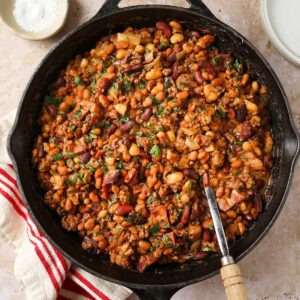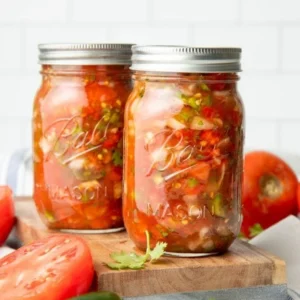Dutch oven recipes have gained immense popularity due to their ability to create rich, flavorful dishes with minimal effort. This versatile cooking tool is perfect for slow cooking, braising, baking, and stewing, allowing flavors to develop over time. Originating in the 17th century in Europe, the Dutch oven was designed for even heat distribution, making it ideal for outdoor cooking and campfires. Today, it’s a must-have for home cooks looking for comforting, hearty meals.
What makes Dutch oven dishes so special is the ability to create meals with tender textures and deep, developed flavors. Whether you’re making a succulent stew or baking artisan bread, the Dutch oven retains heat and moisture, resulting in consistently delicious dishes.
Ingredients
For any great Dutch oven recipe, the ingredients list should be simple yet flavorful. Below is a basic list of ingredients for a classic Dutch oven stew:
- 2 pounds beef stew meat, cubed
- 4 medium potatoes, peeled and cubed
- 3 carrots, sliced
- 1 onion, diced
- 3 cloves garlic, minced
- 1 cup beef broth
- 1 cup red wine (optional)
- 1 teaspoon dried thyme
- 2 bay leaves
- Salt and pepper to taste
- 2 tablespoons olive oil
Substitutions:



- Use chicken or vegetable broth for a lighter stew.
- Swap the beef for chicken or tofu for a vegetarian version.
- Use gluten-free flour or cornstarch to thicken the stew if needed.
Step-by-Step Cooking Instructions
-
Prepare the Ingredients
Begin by prepping all vegetables and meat. Cube the beef, chop the potatoes, and slice the carrots. Mince the garlic and dice the onion. -
Sear the Meat
Heat the Dutch oven over medium-high heat and add 2 tablespoons of olive oil. Once hot, add the beef and sear it until browned on all sides. This step locks in the flavors. Remove the meat and set it aside. -
Sauté the Vegetables
In the same pot, add the diced onion and garlic, sautéing until fragrant (about 2 minutes). Add the carrots and cook for another 5 minutes until softened. -
Deglaze the Pot
Pour in the wine or a bit of broth, scraping the bottom of the pot to release any browned bits (this is where a lot of flavor is). Let it simmer for 2 minutes. -
Add Remaining Ingredients
Return the beef to the pot along with potatoes, thyme, bay leaves, and broth. Stir to combine. Season with salt and pepper. -
Simmer and Cook
Cover the Dutch oven and reduce the heat to low. Let it simmer for 1.5–2 hours, or until the beef is tender and the vegetables are cooked through. Stir occasionally to prevent sticking. -
Final Adjustments
Remove the bay leaves. Taste and adjust seasoning as needed, adding more salt, pepper, or fresh herbs to enhance the flavor.
Pro Tips and Cooking Techniques
- Browning the Meat: Take your time to brown the beef properly—this step enhances the flavor of the stew significantly.
- Avoid Overcrowding: Don’t crowd the Dutch oven when searing the meat. Brown it in batches to get that perfect sear.
- Slow Cooking: The key to a great Dutch oven dish is low and slow cooking. The longer you cook, the more flavorful the dish becomes.
Variations and Customizations
- Vegetarian Dutch Oven Recipe: Swap out the meat for a variety of vegetables like mushrooms, eggplant, and zucchini. Add lentils or beans for protein.
- Gluten-Free: Use gluten-free flour to thicken stews or skip the flour altogether for a naturally thick dish.
- Spicy Twist: Add a few chopped jalapeños or a teaspoon of cayenne pepper to give your dish a kick.
Serving Suggestions
- Serve your Dutch oven stew with warm, crusty bread for dipping.
- Pair it with a green salad dressed in a light vinaigrette for a refreshing contrast.
- A glass of red wine, such as a Merlot or Cabernet Sauvignon, complements the richness of the stew perfectly.
Nutritional Information (per serving)
- Calories: 350
- Protein: 28g
- Carbs: 40g
- Fat: 12g
- Fiber: 5g
- Sodium: 800mg
Frequently Asked Questions (FAQs)
-
Can I make this ahead of time? Yes! Dutch oven dishes often taste better the next day as the flavors have time to develop. Store in an airtight container in the fridge for up to 3 days.
-
Can I freeze Dutch oven stew? Absolutely! Let it cool completely before storing in freezer-safe containers. It will last for up to 3 months. Reheat on the stovetop or in the microwave.
-
How do I avoid burning food in a Dutch oven? Always cook on low to medium heat and keep the lid on to retain moisture. Stir occasionally to ensure even cooking.
Closing Thoughts
Dutch oven recipes are perfect for creating hearty, comforting meals with minimal effort. Whether you’re new to cooking or an experienced chef, the Dutch oven is an invaluable tool in your kitchen. Remember, slow and steady wins the race when it comes to creating the best flavors and textures!



